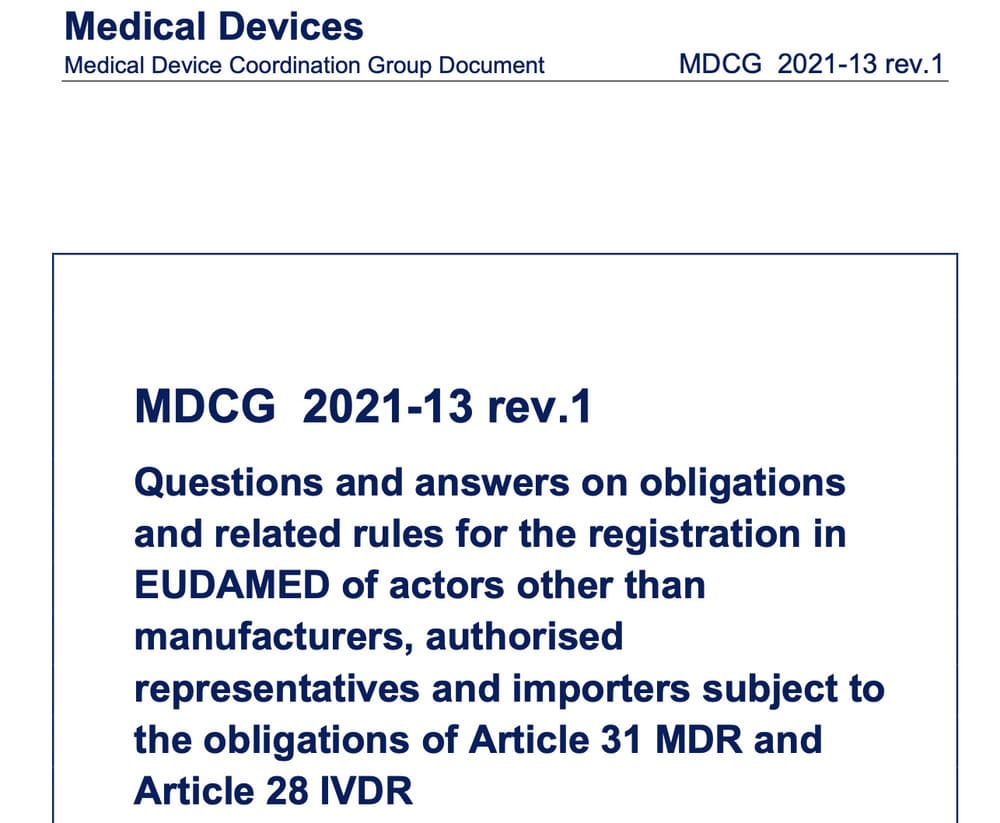
EUDAMED: which players (really) need to register? Deciphering the MDCG 2021-13 guide
Medical devices regulation
The EUDAMED database, the cornerstone of the European regulatory system, requires rigorous registration of all players involved in the life cycle of medical devices. But beyond the manufacturers, agents and importers explicitly covered by the MDR (article 31) and IVDR (article 28), other categories of players are also concerned.
The guide MDCG 2021-13 rev.1, which is still valid in 2025, clears up any ambiguities concerning these specific situations: manufacturers of custom-made devices, legacy devices, kit producers, etc. This article will help you to understand what you need to do, and what you don't.
1. General registration obligations in EUDAMED
The MDR (EU 2017/745) and IVDR (EU 2017/746) regulations require manufacturers, agents and importers to register in EUDAMED before placing a device on the European market. This registration is validated by the competent authority and results in the allocation of an SRN (Single Registration Number).
However, other players, although not directly named in articles 31 and 28, may be required to register. In such cases, they receive an Actor ID, which does not have the same legal scope as an SRN, but which conditions access to certain database functionalities (vigilance, UDI, certificates, etc.).
2. Players concerned by the MDCG 2021-13 guide
The MDCG 2021-13 guide identifies several categories of actors "indirectly" concerned by registration in EUDAMED.
Manufacturers of custom-made devices
In principle, they are exempt from the initial registration obligation, but must register as soon as they are required to submit a vigilance report, or when a certificate is issued for a class III implantable device. The guide specifies that this also applies to non-EU manufacturers and their agents.
They receive an Actor ID, not an SRN.
Manufacturers of legacy devices
Manufacturers of devices covered by a still-valid MDD or AIMDD certificate must register within six months of publication of EUDAMED's notice of full availability (article 123(3)(d) MDR). The same logic applies to IVDR.
Here again, only an Actor ID is issued.
Manufacturers of "old" devices
These are devices placed on the market before the application dates of the regulations (or even before the directives). Registration is only required if an authority requires the transmission of a vigilance report via EUDAMED.
Kit manufacturers (SPPP)
Producers of procedural systems or kits must be registered as soon as they submit UDI data (Annex VI, Part B of the MDR). This implies registration in EUDAMED prior to marketing.
The Actor ID is required to access the UDI module.
Importers or distributors carrying out modifications (Article 16 MDR/IVDR)
An importer or distributor who assumes the obligations of a manufacturer (Article 16(1) MDR/IVDR) - for example, by substantially modifying a device - must register as a manufacturer in EUDAMED.
On the other hand, if he simply relabels or repackages a device without modifying its conformity, with the manufacturer's agreement, and in compliance with the conditions of article 16(2), he does not change his status.
He registers as an importer or distributor, depending on his actual role, but not as a manufacturer.
3. Case studies
Case 1: A Swiss manufacturer of Class III custom-made implantable devices
A Zurich-based company manufactures Class III custom-made dental implants for the European market. To comply with the MDR, it has appointed an agent based in the EU. At the request of a German hospital, a notified body will issue a certificate for a customized Class III implant.
As a result, the manufacturer and the authorized representative must register in EUDAMED before the certificate is issued. Each will receive an Actor ID (not an SRN), with registration validated by the competent authority of the Member State where the product will be marketed (in this case, Germany).
Case 2: A French start-up distributing diagnostic kits based on certified components
This company assembles and sells ready-to-use kits combining several MDR-compliant devices, without modifying their intended use. It plans to add its own UDI data to reference the kits.
Consequence: as a System/Procedure Pack Producer, it must register with EUDAMED before any marketing, in order to deposit the necessary UDI data. It will then obtain an Actor ID.
4. Mini FAQ
What is the difference between an SRN and an Actor ID?
The SRN is reserved for manufacturers, agents and importers registered under articles 31 MDR / 28 IVDR. Other actors receive an Actor ID, which can be used in EUDAMED modules, but has no equivalent regulatory value.
Do legacy device manufacturers still have to register?
Yes, unless the devices are no longer marketed and vigilance obligations no longer apply. Registration is required within 6 months of EUDAMED becoming fully operational.
Is it possible to register voluntarily if you are not yet obliged to do so?
Yes, and the guide even recommends that you do so as soon as data transmission is necessary (for example, in the event of an incident or a certificate in view).
How does a kit manufacturer identify the competent authority to contact?
For a non-EU producer, it's the authority of the Member State where the product will first be marketed. The choice must be justified in the registration form.
Does a manufacturer of old devices still in use need to register?
Only if the national authorities require the transmission of an incident or correction report via EUDAMED. Otherwise, registration is not necessary.
5. Conclusion
The MDCG 2021-13 guide remains a valuable tool for clarifying who needs to register with EUDAMED and when. It is aimed at all the peripheral players in the regulatory system - often forgotten or misinformed.
Are you affected by one of these situations? Are you unsure about your status or that of your partners? At CSDmed, we can help you identify your obligations, manage your registration in EUDAMED and anticipate interactions with the competent authorities. Let's talk about it.
Related resources
EUDAMED: upcoming obligations for medical device manufacturers
Publication of clinical investigation reports: MDCG 2024-15 explained
MDR technical documentation: Avoid common mistakes and follow best practices